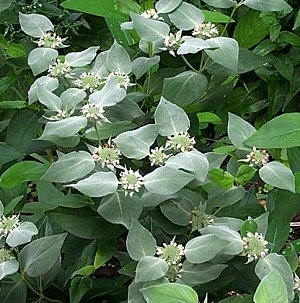 True to my desire to have one of every plant I see, I have a new favorite. Mountain Mint is my newest interest. This plant has been in my garden for several years—I have always liked it but have recently discovered that there are several different species. I only know about three of
them so far.
True to my desire to have one of every plant I see, I have a new favorite. Mountain Mint is my newest interest. This plant has been in my garden for several years—I have always liked it but have recently discovered that there are several different species. I only know about three of
them so far.
The Latin name of this plant is Pycnanthemum (pick-NAN-the-mum) and the one I had first is Pycnanthemum muticum. It is a dependable herbaceous perennial—returning every year and tolerating dividing when I decide to try it in a new spot. It was emphasized as a terrific pollinator at a recent garden event; in fact it was the number one pollinator out
of 86 other native pollinators so it was big news. Also known as Big Leaf mountain mint or Short-toothed mountain mint it was observed hosting every imaginable insect that seeks nectar and pollen—honey bees, bumblebees, soldier bugs, and butterflies. Maybe choosing a pollinator plants doesn’t even make your list of needs when buying a plant (perennial, shrub, or annual),
but it should be a major consideration in order to encourage bees, butterflies, and other small insects. After all, without bees, we would have a very limited diet.
 Don’t be turned off by the fact that it is a mint—you won’t have to worry about it being invasive in the same way as other mints. If you wish to keep it within bounds, you can use a shovel to cut the roots around the plant every spring. It is a relatively tall plant (2-3 feet) with square
stems (the hallmark of a mint) topped by a disk that holds the blooms in small clusters that are slightly pink in color; the whitish bracts surrounding the disks (not petals) are unique and are also decorative. The flowers that attract the insects are extremely tiny and grow in a circle around the center disk, therefore they attract small pollinators—tiny flies, small
carpenter bees. These flowers will last a long time as cut flowers.
Don’t be turned off by the fact that it is a mint—you won’t have to worry about it being invasive in the same way as other mints. If you wish to keep it within bounds, you can use a shovel to cut the roots around the plant every spring. It is a relatively tall plant (2-3 feet) with square
stems (the hallmark of a mint) topped by a disk that holds the blooms in small clusters that are slightly pink in color; the whitish bracts surrounding the disks (not petals) are unique and are also decorative. The flowers that attract the insects are extremely tiny and grow in a circle around the center disk, therefore they attract small pollinators—tiny flies, small
carpenter bees. These flowers will last a long time as cut flowers.
Another mountain mint is Pycnanthemum pilosum. This plant tends to be shorter than P. muticum and the flowers are usually white (sometimes lavender-tinged) with purple spotting. The leaves are broadest on P. muticum and become progressively narrower on P. pilosum and finally, very narrow leaves on P. virginianum. The flower clusters on this mountain mint are very
different. They are arranged in numerous small, dense clusters which bloom only a few at a time and arise from leaf axils at the stem tips. P. virginianum typically occurs in moist soils in wet meadows, swamps and along streams and ponds. It is an erect, many-branched, herbaceous perennial that grows 2-3 feet tall. All three of these plants bloom from July through
September, all three have the typical mint scent, and all three are native to the eastern United States.
If you want to buy this plant, it may be slightly difficult to find—it may be found in the herb section or perennial section of plant nurseries that have a diverse inventory or that specialize in native plants. It can be planted among other plants that tend to spread—monarda, obedient plant or ornamental grasses.
Read other articles on ecological gardening & native plants